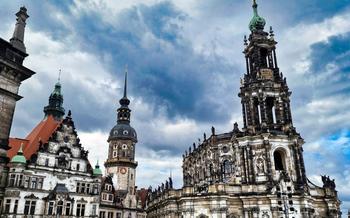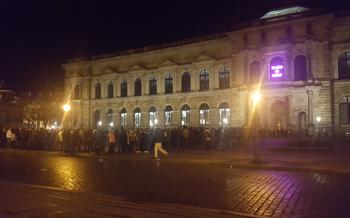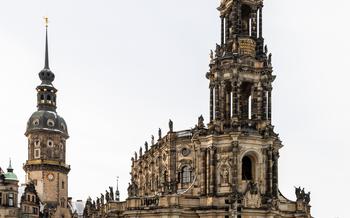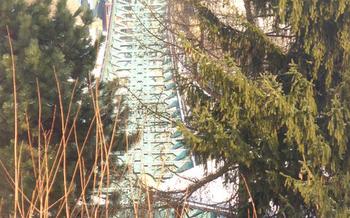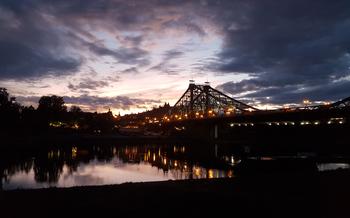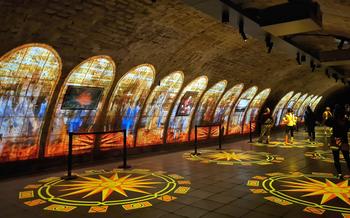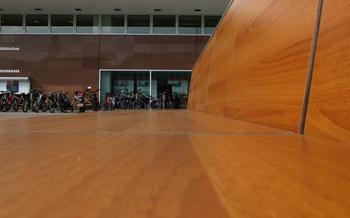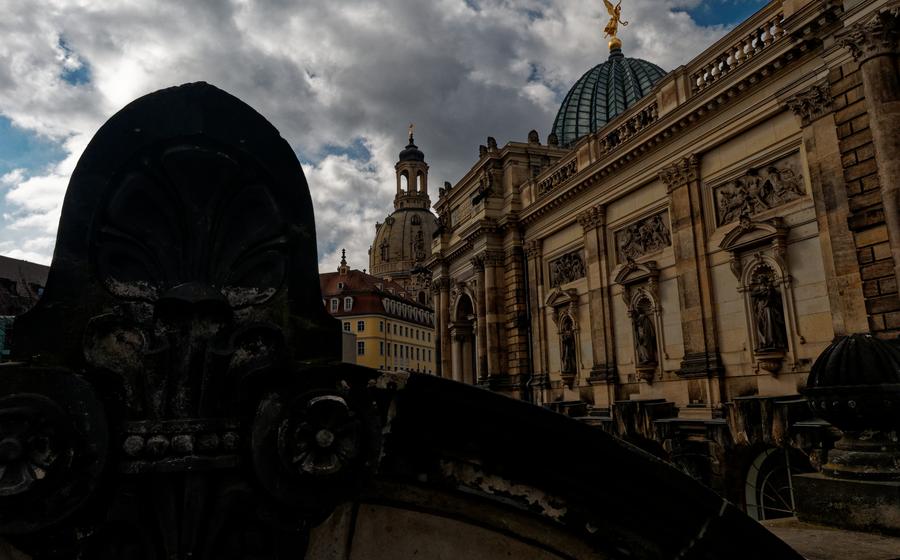
Flower Clock (Blumenuhr)
- Flower Clock (Blumenuhr) - A Unique Timepiece in Dresden
- History of the Clock
- Location and Accessibility
- Design and Construction of the Clock
- Interesting Facts and Trivia
- The Botanical Garden - A Green Haven in the City
- The Zwinger Palace - A Baroque Masterpiece
- The Semper Opera House - A Symbol of Cultural Excellence
- The Elbe River - A Scenic Waterway
- The Church of Our Lady (Frauenkirche) - A Symbol of Resilience
- The New Town (Neustadt) - A Vibrant Neighborhood
- The Kunsthofpassage - A Courtyard of Artistic Wonders
- History and Concept
- Unique Courtyards with Different Themes and Art Installations
- Murals, Sculptures, and Interactive Elements
- A Hidden Gem for Art Enthusiasts
- The Dresden Transport Museum - A Journey Through Transportation History
- The Dresden Zoo - A Home for Exotic Animals
- The Albertinum Museum - A Treasure Trove of Art
- The Royal Palace (Residenzschloss) - A Grand Residence
- The Brühl's Terrace (Brühlsche Terrasse) - A Scenic Promenade
- The Dresden Christmas Market (Striezelmarkt) - A Festive Tradition
- Insider Tip: The Pfund's Molkerei - A Culinary Delight
Flower Clock (Blumenuhr) - A Unique Timepiece in Dresden
In the heart of Dresden, amidst the bustling city center, lies a remarkable timepiece that captures the essence of nature's artistry - the Flower Clock (Blumenuhr). This intricate masterpiece, a harmonious blend of horticulture and horology, has become an iconic symbol of the city's vibrant spirit and its rich cultural heritage.
History of the Clock
The Flower Clock was conceived in 1909 by the renowned landscape architect and horticulturalist Paul Naumann. Driven by his passion for creating innovative urban spaces, Naumann envisioned a clock that would not only tell time but also showcase the beauty and diversity of the plant kingdom. With the support of the Dresden City Council, his ambitious project came to fruition in 1911, transforming a previously neglected plot of land into a captivating spectacle.
Location and Accessibility
Located in the heart of Dresden, the Flower Clock can be found in the Altmarkt, a central square that serves as a hub for both locals and tourists. Its prominent position, nestled amidst the historic buildings and lively atmosphere of the city center, makes it easily accessible by foot or public transportation.
Design and Construction of the Clock
The Flower Clock is a testament to the ingenuity and craftsmanship of its creators. Its design features a large clock face, measuring over 10 meters in diameter, adorned with a mesmerizing array of seasonal flowers. The clock's mechanism, meticulously engineered to ensure precision, is synchronized with the city's official timekeeping system, ensuring its accuracy.
Interesting Facts and Trivia
-
The Flower Clock is the largest of its kind in the world, boasting over 10,000 flowers that are meticulously arranged and replaced throughout the year to ensure a continuous display of vibrant colors.
-
The clock's intricate design allows for twice-daily "performances" when the hands of the clock move to create a captivating spectacle of rotating flowers.
-
The Flower Clock has become a popular symbol of Dresden, featured on postcards, souvenirs, and even postage stamps, solidifying its status as a beloved landmark.
The Botanical Garden - A Green Haven in the City
Variety of Plants and Flowers Featured: Dresden's Botanical Garden is a living treasure trove of plant diversity, showcasing over 10,000 species from around the world. Visitors can wander through thematic gardens, including a rock garden, a Japanese garden, a tropical greenhouse, and a rose garden. The garden is particularly renowned for its extensive collection of orchids, with over 1,500 species on display.
Significance for Research and Conservation: Beyond its aesthetic appeal, the Botanical Garden plays a crucial role in research and conservation. Scientists conduct studies on plant taxonomy, ecology, and genetics, contributing to the understanding and preservation of plant species. The garden also participates in international conservation programs, such as the Seed Bank Network, to safeguard endangered plant species.
Educational and Recreational Activities: The Botanical Garden offers a range of educational and recreational activities for visitors of all ages. Guided tours provide insights into the fascinating world of plants, while workshops and lectures delve deeper into specific topics. Families can enjoy interactive activities, such as plant identification games and scavenger hunts. The garden also hosts special events throughout the year, including concerts, exhibitions, and themed festivals.
Special Events and Exhibitions: The Botanical Garden regularly hosts special events and exhibitions to engage and educate visitors. These events may include plant sales, art exhibitions inspired by nature, and educational programs focused on sustainability and environmental conservation. Visitors can check the garden's website or social media channels for upcoming events and exhibitions.
The Zwinger Palace - A Baroque Masterpiece
In the heart of Dresden's historic city center, the Zwinger Palace stands as a testament to the city's rich cultural heritage and Baroque architectural prowess. Constructed between 1710 and 1728 under the reign of Augustus the Strong, the Zwinger was initially conceived as an orangery and pleasure garden, serving as a venue for lavish festivals and courtly entertainments.
Over the centuries, the Zwinger has undergone several modifications and expansions, resulting in the magnificent complex we see today. Its striking sandstone facade, adorned with intricate carvings, sculptures, and allegorical figures, epitomizes the exuberance and artistry of the Baroque era. The palace's four corner pavilions, crowned with distinctive onion domes, add to its grandeur and visual appeal.
Within the Zwinger's walls lies a treasure trove of cultural institutions. The Gemäldegalerie Alte Meister (Old Masters Picture Gallery) houses a world-renowned collection of paintings by European masters from the 15th to the 18th centuries, including works by Raphael, Titian, and Rembrandt. The Porzellansammlung (Porcelain Collection) showcases exquisite porcelain masterpieces from various European manufactories, including the renowned Meissen porcelain.
The Zwinger is also home to the Mathematisch-Physikalischer Salon (Museum of Mathematics and Physics), which features a fascinating collection of scientific instruments and exhibits on the history of science and technology. The Rüstkammer (Armory) displays an impressive array of historical weapons and armor, providing a glimpse into the military prowess of the Saxon rulers.
The Semper Opera House - A Symbol of Cultural Excellence
The Semper Opera House, or Semperoper, is a world-renowned opera house located in the heart of Dresden. It is considered one of the most prestigious opera houses in Europe and has a rich history dating back to the 19th century. The original opera house, designed by Gottfried Semper, opened in 1841 but was destroyed by fire in 186It was rebuilt and reopened in 1878, only to be damaged again during World War II. The opera house underwent extensive restoration and was finally reopened in 198
Today, the Semper Opera House stands as a testament to the resilience and cultural significance of Dresden. The building is a masterpiece of neo-Renaissance architecture, with its grand facade, intricate sculptures, and opulent interior.
The Semper Opera House is home to the Saxon State Opera, which stages a variety of operas, ballets, and concerts throughout the year. The opera house also hosts the Dresden Philharmonic Orchestra, which is renowned for its world-class performances.
Attending a performance at the Semper Opera House is a truly unforgettable experience. The acoustics are superb, and the performances are of the highest caliber. Visitors can choose from a variety of seating options, including regular seats, boxes, and standing room.
For those interested in learning more about the history and architecture of the opera house, guided tours are available. Visitors can also book behind-the-scenes tours to get a glimpse of the stage, the rehearsal rooms, and the costume department.
When attending a performance at the Semper Opera House, it is important to dress appropriately. Formal attire is not required, but smart casual dress is recommended. It is also important to be on time for the performance, as latecomers may not be admitted.
The Elbe River - A Scenic Waterway
The Elbe River, Germany's second-longest river, flows gracefully through the heart of Dresden, adding a touch of serenity and natural beauty to the city's urban landscape. This majestic river has played a significant role in Dresden's history, serving as a vital trade and transportation route for centuries. Today, it continues to enchant visitors with its scenic vistas, offering a range of opportunities for exploration and relaxation.
One of the best ways to experience the Elbe River is to embark on a leisurely boat tour or cruise. These cruises provide panoramic views of Dresden's iconic landmarks, including the Zwinger Palace, the Semper Opera House, and the Church of Our Lady, all while immersing you in the city's rich history and culture. As you glide along the river, you'll pass through picturesque landscapes, charming villages, and lush forests, creating a memorable and tranquil experience.
For those seeking a more active adventure, the riverfront promenades and parks offer a delightful setting for strolling, jogging, or cycling. These well-maintained paths wind along the riverbanks, providing ample opportunities to admire the stunning scenery and soak up the fresh air. Along the way, you'll encounter historical monuments, serene gardens, inviting cafes, and playgrounds for children, making it an ideal destination for both relaxation and recreation.
The Elbe River is also steeped in cultural and historical significance. It was once a vital trade route, connecting Dresden to other major cities in Europe, and played a crucial role in the city's economic development. The river also witnessed some of the most dramatic events of World War II, including the devastating air raids that destroyed much of Dresden. Today, the Elbe River serves as a poignant reminder of the city's resilience and its ability to rise from adversity.
To fully appreciate the beauty and serenity of the Elbe River, take some time to stroll along its banks, embark on a leisurely boat tour, or simply relax in one of the many riverside cafes. Whether you're seeking adventure, history, or a peaceful escape, the Elbe River promises an unforgettable experience in Dresden.
The Church of Our Lady (Frauenkirche) - A Symbol of Resilience
Rising majestically in the heart of Dresden, the Church of Our Lady (Frauenkirche) stands as a testament to the city's resilience and enduring spirit. Its history is intertwined with that of Dresden, having witnessed the city's rise and fall through the centuries. Originally constructed in the 18th century, the church was considered a masterpiece of Baroque architecture. However, it was tragically destroyed during the Allied bombings of World War II, leaving only a heap of rubble.
The reconstruction of the Frauenkirche was a symbol of hope and reconciliation for the people of Dresden. It began in 1994, using original plans and salvaged materials whenever possible. The painstaking work of skilled craftsmen and artisans brought the church back to life, stone by stone. The new Frauenkirche was finally consecrated in 2005, marking a significant milestone in Dresden's postwar recovery.
Today, the Frauenkirche stands as a symbol of peace and unity. Its exterior features an impressive dome, elegant towers, and intricate sandstone carvings. The interior is equally breathtaking, with its spacious nave, ornate altars, and magnificent stained glass windows. Visitors can climb to the observation deck at the top of the dome for panoramic views of Dresden and the surrounding countryside.
The Frauenkirche is not only a symbol of Dresden's resilience but also a vibrant religious and cultural center. Regular church services, concerts, and exhibitions take place within its walls, bringing together people from all walks of life. The Frauenkirche is a must-visit attraction for anyone interested in history, architecture, or spirituality. It serves as a reminder of the power of hope, the importance of preserving cultural heritage, and the enduring spirit of the human will.
The New Town (Neustadt) - A Vibrant Neighborhood
A Unique Character: Located on the northern bank of the Elbe River, opposite the historic city center, the Neustadt district is a vibrant and lively neighborhood that stands out with its unique character. While the Altstadt boasts grand baroque architecture, the Neustadt is known for its eclectic mix of architectural styles, from Art Nouveau to modern, creating a diverse and visually appealing streetscape.
Independent Charm: The Neustadt is home to a thriving community of independent shops, cafes, and restaurants. Along its charming streets, you'll find unique boutiques offering handmade crafts, vintage clothing, and local design products. Cozy cafes invite you to linger over a cup of coffee and a slice of cake, while small, independent restaurants serve up a diverse range of cuisines from around the world.
Cultural Hub: The Neustadt is also a hub for art and culture, with numerous galleries, theaters, and cultural venues. The Kunsthofpassage, a hidden gem tucked away between buildings, features a series of courtyards adorned with stunning murals, sculptures, and interactive art installations. The Theater Junge Generation, known for its innovative productions, and the tjg. theater junge generation, a venue dedicated to children's and youth theater, are popular cultural destinations.
Nightlife and Entertainment: When the sun goes down, the Neustadt transforms into a vibrant nightlife destination. Lively bars, pubs, and clubs cater to a diverse crowd, offering everything from live music and DJs to karaoke and dance floors. The district's energetic atmosphere and youthful vibe make it a popular spot for locals and visitors alike to let loose and enjoy a night out.
The Kunsthofpassage - A Courtyard of Artistic Wonders
Nestled amidst the bustling streets of Dresden, the Kunsthofpassage is an enchanting hidden gem that showcases the city's vibrant art scene. This unique courtyard complex, consisting of five interconnected passageways, is a testament to the power of creativity and artistic expression.
History and Concept
The Kunsthofpassage was the brainchild of architect and artist Rainer Maria Latzke, who envisioned a space where art could flourish and inspire. In the early 1990s, Latzke and a group of like-minded artists transformed a dilapidated courtyard into a canvas for their artistic creations. Each courtyard within the passageway has a distinct theme, ranging from "The Courtyard of Elements" to "The Courtyard of Metamorphoses," creating a diverse and captivating experience for visitors.
Unique Courtyards with Different Themes and Art Installations
As you stroll through the Kunsthofpassage, you'll be greeted by a kaleidoscope of colors, textures, and forms. Murals adorn the walls, sculptures emerge from unexpected corners, and interactive elements invite you to engage with the art. Highlights include the "Singing Drainpipes" in the Courtyard of Elements, where water flowing through the pipes creates a haunting melody, and the "Giant Coffee Pot" in the Courtyard of Metamorphoses, a whimsical tribute to Dresden's coffee culture.
Murals, Sculptures, and Interactive Elements
The Kunsthofpassage is not just a gallery but also a playground for the senses. Visitors can touch, listen, and interact with the art installations, fostering a deeper connection with the creative process. From the tactile surfaces of the "Stone Forest" to the echoing sounds of the "Whispering Walls," the Kunsthofpassage offers a truly immersive experience.
A Hidden Gem for Art Enthusiasts
If you're seeking an escape from the ordinary and a chance to immerse yourself in the world of art, the Kunsthofpassage is a must-visit destination. This hidden gem is a testament to the boundless imagination of Dresden's artists and a reminder that art can transform even the most unassuming spaces into places of wonder and inspiration.
The Dresden Transport Museum - A Journey Through Transportation History
A Glimpse into the Evolution of Mobility: Nestled in the vibrant city of Dresden, the Dresden Transport Museum invites visitors to embark on a captivating journey through the history of transportation. Discover the ingenuity and innovation that have shaped our modes of travel, from the earliest forms of locomotion to the cutting-edge technologies of today.
Interactive Exhibits and Hands-On Experiences: Step into a world where transportation comes alive through interactive exhibits and hands-on experiences. Explore a replica of a 19th-century steam locomotive, operate a model railroad layout, and witness the evolution of automobile design through interactive displays. The museum's collection of historical vehicles, including vintage cars, motorcycles, and bicycles, offers a tangible connection to the past.
A Treasure Trove of Transportation Artifacts: Delve into the fascinating world of transportation artifacts, where each item holds a story. From ancient maps and navigational instruments to rare automotive parts and historic uniforms, the museum's collection offers a glimpse into the rich history of human mobility. Learn about the challenges faced by early travelers, the technological breakthroughs that transformed transportation, and the impact of transportation on our societies and cultures.
Fun and Educational for All Ages: Whether you're a transportation enthusiast, a history buff, or simply seeking a fun and educational experience, the Dresden Transport Museum has something for everyone. With its interactive exhibits, hands-on activities, and engaging displays, the museum promises an unforgettable journey through the captivating history of transportation.
Insider Tip: For a unique souvenir, visit the museum shop, where you can find a range of transportation-themed gifts and memorabilia, from model trains and vintage posters to books and toys.
The Dresden Zoo - A Home for Exotic Animals
Nestled amidst the lush greenery of the Großer Garten, the Dresden Zoo is a haven for exotic animals from around the globe. Established in 1861, the zoo has a long history of conservation and breeding programs, contributing to the preservation of endangered species.
Spanning over 16 hectares, the zoo is home to over 1,500 animals representing more than 250 species. Visitors can embark on a journey through different habitats, encountering majestic lions, playful penguins, graceful giraffes, mischievous monkeys, and a variety of reptiles and amphibians.
The zoo's commitment to animal welfare is evident in its spacious enclosures, which are designed to mimic the natural environments of the animals. Visitors can observe the creatures engaging in their natural behaviors, such as swimming, climbing, foraging, and socializing.
Educational activities and workshops are regularly organized at the zoo, providing visitors with insights into the fascinating world of animals and their conservation. Children can participate in interactive programs, learning about animal adaptations, habitats, and the importance of protecting wildlife.
Planning a visit to the Dresden Zoo is a rewarding experience for visitors of all ages. Whether you're a family with young children, a nature enthusiast, or simply seeking a day of fun and learning, the zoo offers a memorable encounter with the wonders of the animal kingdom.
The Albertinum Museum - A Treasure Trove of Art
Nestled in the heart of Dresden's historic city center, the Albertinum Museum stands as a testament to the city's rich cultural heritage. This magnificent building, once home to the Royal Armory, now houses an extensive collection of paintings, sculptures, and decorative arts that span various eras and artistic styles.
As you step inside the Albertinum, you'll be greeted by a world of artistic wonders. The museum's collection boasts masterpieces from renowned artists such as Lucas Cranach the Elder, Albrecht Dürer, Caspar David Friedrich, and Claude Monet. Gaze upon the intricate details of Cranach's "Venus and Cupid," marvel at the expressive brushstrokes of Friedrich's "The Wanderer Above the Sea of Fog," and immerse yourself in the vibrant colors of Monet's "Water Lilies."
In addition to its permanent collection, the Albertinum also hosts temporary exhibitions and special events throughout the year. These exhibitions showcase a diverse range of contemporary and historical art, providing visitors with a fresh perspective on the ever-evolving world of art.
To enhance your visit to the Albertinum, consider joining a guided tour or renting an audio guide. These informative tours offer insights into the museum's collection, the history of the building, and the stories behind the artworks. With so much to explore, the Albertinum Museum is a must-visit destination for art enthusiasts and anyone seeking a glimpse into Dresden's vibrant cultural scene.
The Royal Palace (Residenzschloss) - A Grand Residence
The Royal Palace, also known as the Residenzschloss, is a magnificent architectural testament to Dresden's rich history and royal heritage. Situated in the heart of the city, this grand palace has served as the official residence of the Saxon electors and kings for over 400 years.
Built in the 15th century, the Royal Palace underwent several expansions and renovations over the centuries, resulting in a captivating blend of architectural styles, from Gothic to Renaissance and Baroque. Its imposing facade, adorned with intricate carvings and sculptures, hints at the opulence and grandeur that await within.
Today, the Royal Palace houses a number of museums and exhibitions, showcasing the diverse cultural and historical treasures of Saxony. The Green Vault, one of the palace's most renowned attractions, is a dazzling display of precious jewels, gold, and silverware, including the famous Dresden Green Diamond. The State Apartments, once home to the Saxon rulers, offer a glimpse into their lavish lifestyle, with opulent furnishings, tapestries, and works of art.
To fully appreciate the grandeur of the Royal Palace, visitors can embark on a guided tour, which provides insights into the palace's fascinating history and allows access to hidden corners and secret chambers. The palace also hosts special events and exhibitions throughout the year, offering visitors a unique opportunity to experience its vibrant cultural heritage.
Whether you're a history buff, an art enthusiast, or simply looking to marvel at architectural splendor, the Royal Palace is a must-visit attraction in Dresden. Its rich history, stunning architecture, and captivating exhibits make it a treasure trove of cultural wonders, waiting to be explored.
The Brühl's Terrace (Brühlsche Terrasse) - A Scenic Promenade
Along the banks of the Elbe River, nestled amidst the vibrant city of Dresden, lies the picturesque Brühl's Terrace (Brühlsche Terrasse). This iconic promenade offers breathtaking panoramas of the river, the city skyline, and the surrounding landscapes, making it a beloved spot for locals and tourists alike.
Stroll along the terrace and admire the majestic views of the Elbe River, with its glistening waters reflecting the sunlight. Gaze upon the cityscape, dotted with historical buildings and architectural marvels, including the Zwinger Palace, the Semper Opera House, and the Church of Our Lady. The terrace provides a unique perspective from which to appreciate the beauty and grandeur of Dresden.
As you wander along the promenade, you'll encounter a series of historical buildings and monuments that tell the story of Dresden's rich past. Admire the magnificent Brühl's Palace, once home to the Saxon court, and the Albertinum Museum, housing a treasure trove of art and sculptures. Take a moment to pause at the equestrian statue of King Augustus the Strong, a symbol of Dresden's regal heritage.
The Brühl's Terrace is not just a place to admire the scenery; it's also a vibrant hub of activity. Outdoor cafes and restaurants line the promenade, offering a delightful spot to relax and soak in the atmosphere. Indulge in a leisurely lunch or dinner while enjoying the stunning river views. As the evening draws near, the terrace transforms into a magical setting, with the city lights reflecting on the water, creating a captivating ambiance.
Whether you're seeking a tranquil stroll, a romantic rendezvous, or a vibrant evening out, the Brühl's Terrace offers an unforgettable experience. Its scenic vistas, historical charm, and lively atmosphere make it a must-visit destination in Dresden. So, take a leisurely walk along the promenade, embrace the beauty of the surroundings, and create lasting memories in this enchanting riverside haven.
The Dresden Christmas Market (Striezelmarkt) - A Festive Tradition
The Dresden Christmas Market, also known as the Striezelmarkt, is one of the oldest and most renowned Christmas markets in Germany. With a history dating back to the 15th century, this festive event attracts millions of visitors each year. The market is held in the heart of the city, around the Altmarkt square, and offers a magical and enchanting atmosphere.
Stalls adorned with twinkling lights and festive decorations line the streets, showcasing an array of traditional crafts, ornaments, and gifts. Visitors can browse through handcrafted wooden toys, intricate glass ornaments, and unique souvenirs, perfect for finding that special holiday gift. The air is filled with the sweet aroma of roasted almonds, mulled wine, and gingerbread, adding to the festive ambiance.
Indulge in delectable culinary delights at the market, where vendors offer a variety of traditional treats. Sample the famous Dresdner Stollen, a sweet bread filled with dried fruits and spices, or warm up with a cup of Glühwein, a mulled wine that will chase away the winter chill. Other popular treats include Lebkuchen, a type of gingerbread, and Pulsnitzer Pfefferkuchen, a spicy gingerbread cake.
The Dresden Christmas Market is not just about shopping and eating; it's also a place to experience the joy and magic of the holiday season. There are numerous events and activities to keep visitors entertained, such as live music performances, traditional dance shows, and storytelling sessions for children. The market also features a large Christmas pyramid, a traditional German decoration that is a symbol of the season.
Whether you're looking for unique gifts, delicious food, or simply want to soak up the festive atmosphere, the Dresden Christmas Market is a must-visit during the holiday season. Immerse yourself in the magic of this enchanting event and create lasting memories with your loved ones.
Insider Tip: The Pfund's Molkerei - A Culinary Delight
Amidst the vibrant culinary scene of Dresden, there lies a hidden gem that has captured the hearts of locals and visitors alike - Pfund's Molkerei. Founded in 1880, this traditional dairy has been a beloved institution for generations, renowned for its exceptional milk products and mouthwatering ice cream.
Step into Pfund's Molkerei, and you'll be greeted by a charming ambiance that transports you back in time. The walls are adorned with antique tiles, and the air is filled with the sweet aroma of fresh milk and cream. Indulge in a glass of their signature Milchkaffee (milk coffee), a local favorite that perfectly balances the richness of coffee with the smoothness of fresh milk.
But it's the ice cream that truly sets Pfund's Molkerei apart. Made with fresh, high-quality ingredients, their ice cream boasts a velvety texture and an explosion of flavors. From classic favorites like vanilla and chocolate to unique creations like lavender and elderflower, there's a flavor to satisfy every palate.
Don't miss the opportunity to sample their seasonal specialties, which showcase the best of local produce. In the summer, refresh yourself with a scoop of their strawberry sorbet, bursting with the sweetness of sun-ripened berries. In the winter, warm up with a cup of their hot chocolate, made with rich, creamy milk and topped with a generous dollop of whipped cream.
Whether you're looking for a quick snack or a leisurely treat, Pfund's Molkerei is the perfect destination. Experience the taste of tradition and indulge in the culinary delights that have made this dairy a beloved institution in Dresden.
